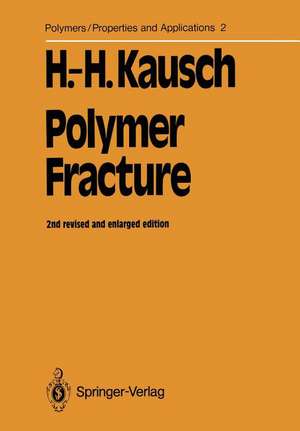Polymer Fracture: Polymers - Properties and Applications, cartea 2
Autor Hans-Henning Kauschen Limba Engleză Paperback – 7 dec 2011
Preț: 956.18 lei
Preț vechi: 1166.08 lei
-18% Nou
Puncte Express: 1434
Preț estimativ în valută:
182.97€ • 191.42$ • 151.99£
182.97€ • 191.42$ • 151.99£
Carte tipărită la comandă
Livrare economică 03-17 aprilie
Preluare comenzi: 021 569.72.76
Specificații
ISBN-13: 9783642696305
ISBN-10: 3642696309
Pagini: 476
Ilustrații: XIV, 456 p.
Dimensiuni: 170 x 244 x 25 mm
Greutate: 0.75 kg
Ediția:2nd ed. 1987. Softcover reprint of the original 2nd ed. 1987
Editura: Springer Berlin, Heidelberg
Colecția Springer
Seria Polymers - Properties and Applications
Locul publicării:Berlin, Heidelberg, Germany
ISBN-10: 3642696309
Pagini: 476
Ilustrații: XIV, 456 p.
Dimensiuni: 170 x 244 x 25 mm
Greutate: 0.75 kg
Ediția:2nd ed. 1987. Softcover reprint of the original 2nd ed. 1987
Editura: Springer Berlin, Heidelberg
Colecția Springer
Seria Polymers - Properties and Applications
Locul publicării:Berlin, Heidelberg, Germany
Public țintă
ResearchCuprins
1 Deformation and Fracture of High Polymers, Definition and Scope of Treatment.- References.- 2 Structure and Deformation.- I. Elements of the Superstructure of Solid Polymers.- II. Deformation.- III. Model Representation of Deformation.- References.- 3 Statistical, Continuum Mechanical, and Rate Process Theories of Fracture.- I. Introduction.- II. Statistical Aspects.- III. Continuum and Fracture Mechanics Approach.- IV. Rate Process Theories of Fracture.- References.- 4 Strength of Primary Bonds.- I. Covalent Bonds.- II. Bond Energies.- III. Form of Binding Potential.- References.- 5 Mechanical Excitation and Scission of a Chain.- I. Stress-Strain Curve of a Single Chain.- II. Axial Mechanical Excitation of Chains.- III. Deexcitation of Chains.- References.- 6 Identification of ESR Spectra of Mechanically Formed Free Radicals.- I. Formation.- II. EPR Technique:.- III. Reactions and Means of Identification.- IV. Assignment of Spectra.- References.- 7 Phenomenology of Free Radical Formation and of Relevant Radical Reactions (Dependence on Strain, Time, and Sample Treatment).- I. Radical Formation in Thermoplastics.- II. Free Radicals in Stressed Rubbers.- III. Mechanically Relevant Radical Reactions.- References.- 8 The Role of Chain Scission in Homogenous Deformation and Fracture.- I. Small-Strain Deformation and Fracture of Highly Oriented Polymers.- II. Deformation, Creep, and Fatigue of Unoriented Polymers.- III. Environmental Degradation.- References.- 9 Molecular Chains in Heterogeneous Fracture.- I. Linear Elastic Fracture Mechanics.- II. Crazing.- III. Molecular and Morphological Aspects in Crack Propagation.- References.- 10 Fracture Mechanics Studies of Crack Healing.- I. Introduction.- II. Models of Adhesive and Cohesive Joint-Strength.- III. Experimental Studies.- References.- Appendix Table A.1. List of Abbreviations of the Most Important Polymers.- Table A.2. List of Abbreviations not Referring to Polymer Names.- Table A.3. List of Symbols.- Table A.4. Conversion Factors.






















